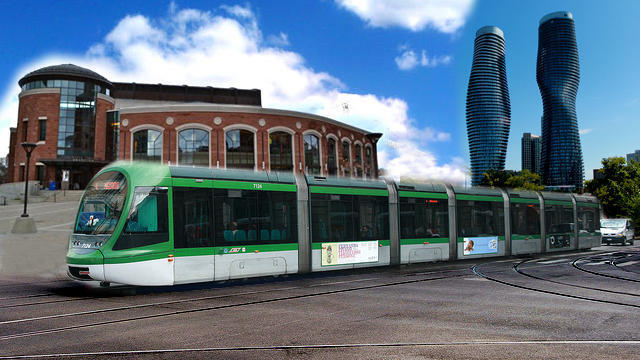LRT tunnel now up $2.8 billion but still best bet for quick commutes in Brampton
Published March 9, 2023 at 11:26 am

The cost of Brampton’s proposed Light Rail Transit tunnel has gone up more than a billion dollars in the last year alone but comes with fewer drawbacks and quicker commutes.
That’s according to an update from City staff last month who have been weighing the pros and cons of an all-above-ground track or a partial underground tunnel for the planned LRT transit line along Main St. to the Brampton GO Station.
But the cost of both options has gone up drastically in recent years with the surface option more than doubling from approximately $422 million in 2022 to $933 million, while the underground tunnel route jumped from $1.7 billion to $2.8 billion.
Even with a more than $1 billion spike in the tunnel’s bottom line due to design updates, construction costs and inflation, City staff say the tunnel is still the best bet for moving people quickly and efficiently along the LRT line.
The surface option would be a 4-kilometre stretch of track running from south of Steeles Ave. to the Brampton GO Station with five stops along the route, while the tunnel option would also use surface streets before going underground from Nanwood Dr. to the downtown.
The tunnel would have four stops – two above ground and two below. From Steeles Ave. to the Peel Village Pkwy. the route would run above ground before going underground.
Staff said the surface opinion will have a “significant” impact on travel times with transit trips on the surface route taking two to three minutes longer compared to the tunnel route. But the travel time for cars on the route would increase up to 17 minutes for drivers headed northbound as the road goes from four lanes down to two at Wellington St. where the LRT will share the road with mixed traffic.
Brampton Mayor Patrick Brown said the surface option could “become a standstill” for drivers stuck in traffic for an estimated twenty-four minutes in a short stretch of road.
“That’s a downtown Toronto commute time,” Brown said after the presentation. “It’s sending a message ‘don’t come into our downtown.'”
Despite being one-third the cost of the tunnel route, staff said the surface option’s impacts on transit, cycling, travel times, heritage impacts and operating costs among other issues.
Staff say the surface option has drawbacks in all categories related to transportation, impacts to downtown, future extension, operation and maintenance and property, while the underground route performed worse in when it comes to cost and construction schedule.
Council’s position is that the tunnel alignment is preferred over an all-above-ground track and Brown has repeatedly championed the underground option as the best bet for the City’s heritage area in the downtown.
The original transit assessment project process was approved back in September 2014 and the design included a surface alignment along Main St. into downtown Brampton. Funding from the Province was announced in 2015, and Council greenlit construction up to Steeles Ave. in October of that same year.
Then in 2017, Council directed City staff to look at alternate routes from Steels into the downtown, looking at Kennedy Rd. or McLaughlin Rd., and had Metrolinx move the station from the north side to the south side. But the project took another turn when a new Council was elected in 2018 and directed staff to focus on the Main St. route as originally planned.
A survey of residents by the City found that 54 per cent of those polled preferred the tunnel option.
“Basically, what we are hearing from the public is ‘get on with it,'” Senior Project Engineer Compton Bobb told Council. ‘”Whatever option you choose, get on with it.'”
INsauga's Editorial Standards and Policies








